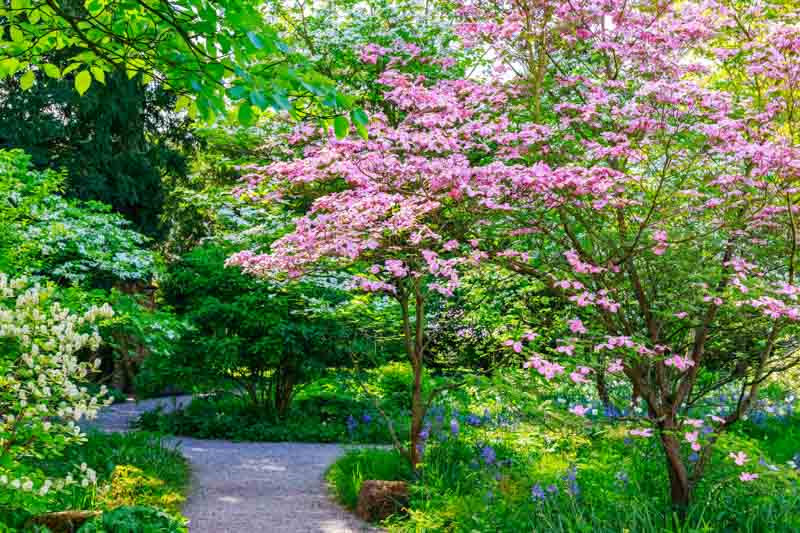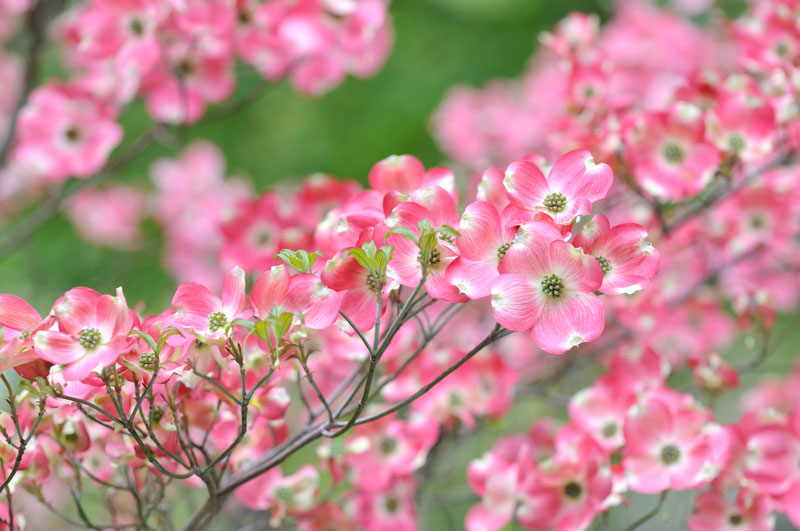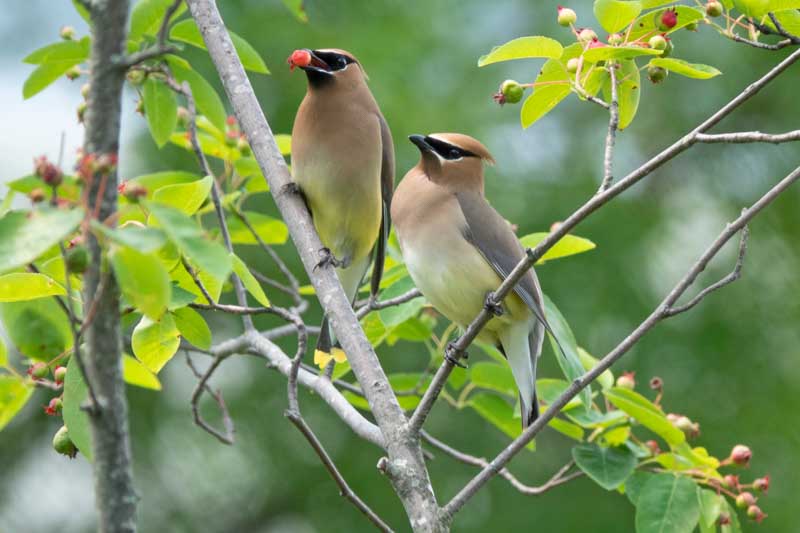Did you know that some dogwood species have been used for centuries in traditional medicine, and the wood of these trees is renowned for its durability in tool handles or golf club heads?
The Dogwood tree, known for its enchanting beauty and understated elegance, is a staple in many landscapes and gardens. But beyond its beauty, the Dogwood harbors a host of fascinating and lesser-known facts.
The Dogwood tree, a member of the genus Cornus, is widely cherished for its ornamental beauty and versatility. This genus comprises over 50 species, ranging from compact shrubs to sizable trees, each with unique characteristics. Among the most popular species are:
Cornus florida: Commonly known as the Flowering Dogwood, this North American native is renowned for its stunning white or pink bracts that herald the arrival of spring.
Cornus kousa: Often referred to as the Kousa Dogwood or Japanese Dogwood, this East Asian native blooms slightly later than Cornus florida. It is distinguished by its star-shaped bracts and enhanced disease resistance.
Cornus mas: Known as the Cornelian Cherry Dogwood, it stands out with its small, bright yellow flowers and edible red fruits.
Cornus nuttallii: The Pacific Dogwood, native to the western United States and Canada, is noted for its large white bracts and red berries.
Cornus alternifolia: The Pagoda Dogwood, named for its layered, horizontal branches, is appreciated for its distinctive growth pattern and clusters of white flowers.

Cornus florida – Flowering Dogwood
The Dogwood tree is a magnificent addition to any landscape, offering a unique blend of vibrant beauty and year-round interest. In spring, it captivates with delicate blossoms, typically in shades of white, pink, or red, transforming into a lush canopy of green in summer. Autumn brings a fiery display of red, orange, and purple leaves, while the winter reveals a striking architectural form with textured bark. This tree’s moderate size makes it ideal for various garden settings, from accentuating lawns to framing garden pathways, enhancing the overall aesthetic with its changing seasonal palette.
Dogwoods, though celebrated for their ornamental beauty, harbor more than just aesthetic value. The wood of these trees is known for its exceptional hardness and density, traits that lend it to a variety of practical applications. This toughness makes Dogwood wood highly suitable for crafting durable tool handles, able to withstand wear and tear. In the world of sports, its resilience is perfect for manufacturing robust golf club heads. Even in finer crafts, such as jewelry making, Dogwood’s dense wood is favored for creating jeweler’s blocks.
Dogwoods have a long and ancient history. Fossils of plants similar to today’s Dogwoods have been found that are over 60 million years old, dating back to the Paleocene epoch. This means that Dogwoods have been around since the time of the dinosaurs, surviving through huge changes in the Earth’s climate and environment. Their presence today is a testament to their incredible ability to adapt and endure over the ages.
The Dogwood tree, particularly notable for its beautiful flowers and distinctive, twisted branches, is significant in Christian folklore. According to legend, the Dogwood was once a large and sturdy tree. It’s said that its wood was used to construct the cross on which Jesus was crucified. Distraught by this use, the tree was forever altered by God. He decreed that the Dogwood tree would never grow large enough again to be used for a cross.
As a symbol of this promise, the flowers of the Dogwood tree are shaped like a cross, with two long and two short petals. Each petal bears a nail mark, and the flower’s center resembles a crown of thorns, serving as a reminder of the crucifixion of Jesus and the tree’s role in it. Though not Biblically based, this legend underscores the deep cultural and spiritual symbolism often found in nature.
Cornus kousa – Kousa Dogwood with a Crop of Berry-like Fruits
The fruit of the Dogwood, often overlooked, is actually edible. It’s small and red and has been used to make wine and preserves. However, not all Dogwood species have palatable fruit. Here are a few notable species that produce edible fruit, although the palatability and appeal can vary between species:
Cornus kousa (Kousa Dogwood): The Kousa Dogwood is known for its roughly spherical berry-like fruits, which are about 1-2 inches (2-5 cm) in diameter. They have a sweet, creamy flavor similar to persimmon when ripe and are sometimes used for making wine.
Cornus mas (Cornelian Cherry Dogwood): This species produces elongated, cherry-like fruits that are edible and quite flavorful. The fruits are commonly used in European and Middle Eastern cuisines for syrups, preserves, and liqueurs. They are tart when raw but sweeten upon cooking.
Cornus capitata (Himalayan Strawberry Tree): Although less common, this species bears edible strawberry-like fruits with a mild, sweet flavor.

Cornus florida – Flowering Dogwood in full bloom
Despite their name, the “flowers” of a Flowering Dogwood Tree (Cornus florida) are not true flowers. What many assume to be petals are actually bracts – modified leaves – that surround the tree’s true flowers, which are small and inconspicuous. These bracts, typically white or pink, serve to attract pollinators to the small clustered flowers at their center. This unique botanical feature is a clever adaptation, giving the Dogwood its iconic springtime beauty that captivates so many.

Cedar Waxwings in a Dogwood Tree
Dogwoods play a significant role in their ecosystems. Their flowers provide nectar for pollinators, while the fruits are a food source for birds and mammals. Additionally, they act as host plants for various butterfly and moth species.
Nectar and Pollinators: Dogwood flowers, particularly those of Cornus florida and Cornus kousa, are rich in nectar, attracting various pollinators. Bees, butterflies, and even some beetles are common visitors. The nectar provides essential nutrition for these insects, particularly in early spring when other food sources may be scarce.
Fruits and Wildlife: The fruits of Dogwoods, especially those of Cornus florida, are a crucial food source for many bird species, including robins, cardinals, and waxwings. The berries are high in fat and calories, making them ideal, especially in late summer and autumn. Mammals like squirrels and chipmunks also feed on Dogwood fruits, helping in seed dispersal.
Host Plants for Butterflies and Moths: Dogwood trees, such as Cornus florida, serve as host plants for the larvae of several butterfly and moth species. For instance, the Spring Azure butterfly (Celastrina ladon) uses Dogwood as a larval host plant.
Beyond their ornamental charm, Dogwood trees possess notable medicinal properties. Historically, Native Americans utilized the bark of certain Dogwood species for its healing qualities. Rich in tannins, it was used to reduce fevers and soothe ailments such as malaria and headaches. The inner bark of the Flowering Dogwood, Cornus florida, was often used as a pain reliever and as a tea for treating colds. The bark was often used as a substitute for quinine during the Civil War.
Cornus mas – Cornelian Cherry Dogwood
Not all Dogwoods have the iconic four-petal white or pink bracts. In fact, the Dogwood family exhibits a surprising diversity in its flowering. Take, for instance, the Cornus mas, also known as the Cornelian Cherry Dogwood. It breaks the mold with its small, starry yellow flowers that brighten gardens in early spring.
The Dogwood is both the state tree and the state flower of Virginia. It’s also the state tree of Missouri and the state flower of North Carolina.
As autumn arrives, Dogwood trees transform into a spectacular display of vibrant hues, painting the landscape with their seasonal beauty. Their leaves, which gracefully adorn the branches throughout the year, begin to change into a vivid tapestry of colors ranging from deep reds to fiery oranges and rich purples. This dramatic change not only enhances the aesthetic appeal of fall gardens but also signifies the tree’s preparation for the winter ahead. The brilliant autumn foliage of Dogwoods provides a striking contrast against the fading greens of late summer, making them a cherished feature in both natural settings and cultivated landscapes.
On average, many Dogwood species can live between 20 to 30 years, but under ideal conditions and with proper care, they can survive much longer, often up to 80 years or more. Factors such as species, environmental conditions, soil quality, water availability, and care practices significantly influence their longevity.
Dogwood Anthracnose on Dogwood Leaves
Dogwood Anthracnose, a devastating disease caused by the fungus Discula destructiva, poses a significant threat to Dogwood trees, especially the Cornus florida species. Characterized by telltale signs like unsightly leaf spots, tan blotches, and purple-rimmed lesions, the infection rapidly progresses, leading to stem dieback and large, sunken cankers on the trunk. In severe cases, this disease can be lethal, causing the entire tree to decline and eventually die.
The impact on Dogwood populations has been substantial, particularly in forested and natural settings, where these symptoms are more than just a cosmetic concern but a real threat to the tree’s survival. Flowering Dogwoods – Problems and Alternatives
| Hardiness |
5 - 9 |
|---|---|
| Plant Type | Shrubs, Trees |
| Genus | Cornus |
| Exposure | Full Sun, Partial Sun |
| Season of Interest |
Spring (Early, Mid, Late) Summer (Early, Mid, Late) Fall Winter |
| Maintenance | Low |
| Water Needs | Average |
| Soil Type | Chalk, Clay, Sand |
| Soil pH | Acid, Neutral |
| Soil Drainage | Moist but Well-Drained, Well-Drained |
| Characteristics | Showy |
| Native Plants | United States, Maryland, Massachusetts, New York, New Jersey, New Hampshire, Maine, Delaware, Rhode Island, Pennsylvania, Vermont, Connecticut, Southeast, Southwest, Northeast, Midwest, Kansas, Ohio, Missouri, Illinois, Indiana, Minnesota, Arkansas, Alabama, Florida, Kentucky, Georgia, North Carolina, Mississippi, Louisiana, South Carolina, West Virginia, Tennessee, Virginia, Oklahoma, Texas |
| Attracts | Bees, Birds, Butterflies |
| Landscaping Ideas | Beds And Borders |
| Garden Styles | City and Courtyard, Informal and Cottage |
| Hardiness |
5 - 9 |
|---|---|
| Plant Type | Shrubs, Trees |
| Genus | Cornus |
| Exposure | Full Sun, Partial Sun |
| Season of Interest |
Spring (Early, Mid, Late) Summer (Early, Mid, Late) Fall Winter |
| Maintenance | Low |
| Water Needs | Average |
| Soil Type | Chalk, Clay, Sand |
| Soil pH | Acid, Neutral |
| Soil Drainage | Moist but Well-Drained, Well-Drained |
| Characteristics | Showy |
| Native Plants | United States, Maryland, Massachusetts, New York, New Jersey, New Hampshire, Maine, Delaware, Rhode Island, Pennsylvania, Vermont, Connecticut, Southeast, Southwest, Northeast, Midwest, Kansas, Ohio, Missouri, Illinois, Indiana, Minnesota, Arkansas, Alabama, Florida, Kentucky, Georgia, North Carolina, Mississippi, Louisiana, South Carolina, West Virginia, Tennessee, Virginia, Oklahoma, Texas |
| Attracts | Bees, Birds, Butterflies |
| Landscaping Ideas | Beds And Borders |
| Garden Styles | City and Courtyard, Informal and Cottage |
Create a membership account to save your garden designs and to view them on any device.
Becoming a contributing member of Gardenia is easy and can be done in just a few minutes. If you provide us with your name, email address and the payment of a modest $25 annual membership fee, you will become a full member, enabling you to design and save up to 25 of your garden design ideas.
Join now and start creating your dream garden!
Create a membership account to save your garden designs and to view them on any device.
Becoming a contributing member of Gardenia is easy and can be done in just a few minutes. If you provide us with your name, email address and the payment of a modest $25 annual membership fee, you will become a full member, enabling you to design and save up to 25 of your garden design ideas.
Join now and start creating your dream garden!